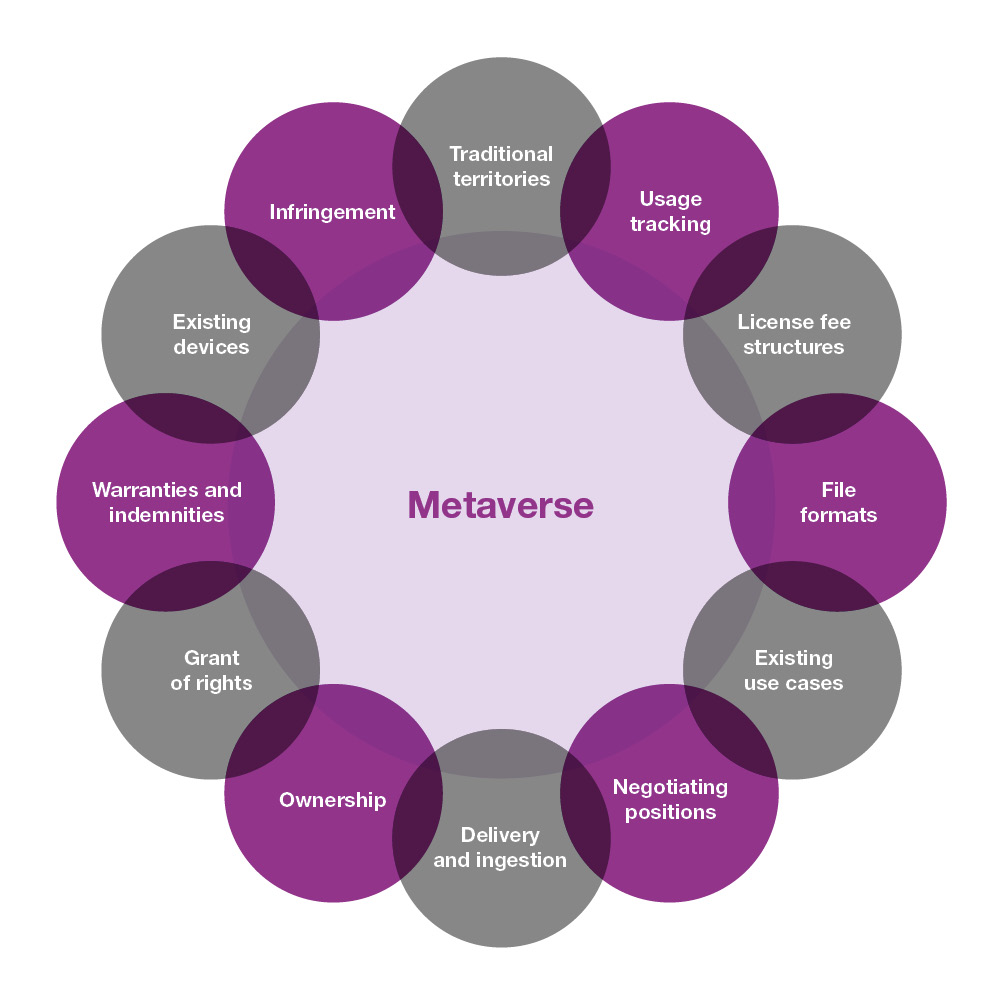Key challenges
While the terms of any license will vary depending on the content and use case, among other factors, there are several common factors that will need to be carefully considered when licensing content for use in the metaverse, as further set out below.

The above is by no means an exhaustive list of the challenges the metaverse brings to content licensing, but it represents some of the key commercial and legal issues that will need to be considered by licensees and licensors. Flowing from these overarching considerations are other challenges that will also need to be assessed, such as usage tracking, file format standardization, delivery and ingestion of content, scope of warranties and indemnities, and conduct of claims for infringing use, among others.

Different perspectives
Inevitably, licensors and licensees will have different perspectives on these key challenges. Licensors will likely seek to maintain a restrictive approach to licensing in the metaverse, for example, by limiting the grant of rights and clearly defining the licensed services, devices, and uses, unless there is a substantial financial incentive otherwise. The underlying considerations will remain the same – licensors want to control how their content (and ultimately their brand) is used and consumed. Licensees typically want as broad a license as possible, as this allows them to be more creative with content exploitation and to take advantage of market developments and trends. This will be even more important in the metaverse, as the rights implicated in certain key use cases, such as the exploitation of NFTs, remain subject to debate. Service providers with existing licenses will need to determine whether such licenses are sufficient. The reach, immediacy, and interactivity of the metaverse will demand the broadest set of rights possible, and it will likely be more important than before for licensees to negotiate rights of first refusal for new forms of exploitation or new digital worlds. Licensors and licensees will need to consider the overarching user experience when negotiating the scope of the grant of rights. The licenses that facilitate content exchange in the metaverse will need to be flexible enough to ensure a seamless user experience between increasingly overlapping and interconnected services. This may force conservative licensors to provide greater flexibility regarding bundling and associated limitations, but equally makes it ever more important for licensors to ensure that their reputations and brands are adequately protected (as further set out in the Deepfakes in the metaverse section).
Key industries
While there are some key challenges that will apply across a variety of different sectors (as further set out in the Advertising, Games, and Music sections), different industries will face their own particular issues in terms of content licensing in the metaverse.
Advertising – The right to include a song or other item of content in any form of advertising is often strictly controlled. Even if such rights are granted, they are often subject to numerous restrictions and approvals, such as payment obligations to performers, singers, and musicians under the various SAG-AFTRA and American Federation of Musicians (AFofM) collective bargaining agreements. While the licensee may not be a signatory, the licensor will typically include a specific provision that requires the licensee to nonetheless comply with such collective bargaining agreements. In addition, rights holders want to ensure that their content is not being used to promote a product they do not support, or in a way that does not fit with the creator’s image. This will be even harder to manage in the metaverse because there will be numerous scenarios in which a particular advertisement is viewed, depending on how the viewer interacts with the metaverse. In the United States, individuals appearing in the content being licensed (including deceased individuals) may have rights of publicity that require permission for the use of their likenesses (including digital ones) in advertising. The metaverse will likely become a source of advertising inventory (for example, virtual billboards, point of sale at virtual stores, event sponsorships, etc.), raising questions regarding how best to track and measure the effectiveness of and engagement with virtual advertisements. Similarly, there will be sponsorship and branding opportunities, and sponsors will need to consider the extent to which any real-world restrictions on these activities will apply in the metaverse.
Games – Gaming and e-Sport companies will most easily be able to adapt their existing services and operations to function seamlessly in the metaverse. Because of this head start, “players” in this industry should, on the one hand, carefully consider how to protect their content and assets while also exploring how they can license out their rights to other less metaverse-ready industries. On the other hand, the traditional use of buyout models in the content creation process means they are not constrained by a limited grant of rights. Companies operating in this space will likely be the leaders in pushing the boundaries of content licensing as the metaverse continues to grow.
Music – Usage tracking poses a particular challenge for music licensing in the metaverse, particularly when you layer in the SAG-AFTRA and AFofM payment requirements for songs recorded under their collective bargaining agreements (which includes most songs from major labels). With different services, devices, and use cases, the likelihood of receiving duplicate or triplicate claims for a single use are even greater. Already complex and expensive usage tracking and reporting systems will need to be adapted to deal with the interactivity inherent within the metaverse. Existing collective management licensing structures will also need to be examined, particularly considering what rights such entities will hold in the metaverse and whether they will continue to license on a territorial basis.
Social media – The terms and conditions for the use of social media services set out intellectual property ownership provisions, but the increased interactivity across services and devices in the metaverse will likely blur the lines between where one service begins and another ends and, therefore, which terms will be controlling and also who owns the IP created. Similarly, if a user creates a piece of content in one corner of the metaverse, questions will arise as to how it will be licensed in another area and who will be liable for any infringing use. Increasingly, end users may demand compensation for any such exploitation – meaning that service providers will need to consider how revenues can be shared across different services and devices.
Film and TV – We are already starting to see increased interactivity in how we view film and TV – take, for example, interactive TV and films on Netflix, such as Bandersnatch and You vs. Wild. As the metaverse continues to grow, there will likely be additional opportunities to exploit existing audio-visual content formats within the metaverse as well (think of movie theatres and branded digital merchandise for your avatars). There is more opportunity for increased interactivity between content creators and viewers in the metaverse, both with and between viewers and also with their surroundings, which will create new opportunities for content origination and funding, and may also impact how stories are told. This may also raise ownership issues: to what extent does the viewer transition to a creator who holds certain rights in the content, and what does that mean for continued exploitation of the content? Also, what does it mean if the interactivity leads to infringement of another party’s rights? And who is liable: the producer or the interactive viewer?
What you can do to prepare
As the metaverse evolves, we will see an influx of the development of new services and devices to facilitate user engagements. New entrants will need to prepare bespoke agreements for how content is licensed. At the same time, existing service and device providers will transition their services to fit the metaverse, and they may wish to review existing content licenses to determine whether they are sufficient. For the reasons set out above, this will not be an entirely straightforward exercise as there are new challenges to consider in the metaverse. Existing stakeholders will need to either enter new licenses or amend existing ones to build in the flexibility necessary to operate successfully in the metaverse.


